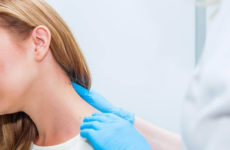According to statistics, half of the inhabitants of the planet are infected with the papilloma virus. It occurs more frequently in women than in men. So, which doctor should be treated with papilloma , who treats papillomas?
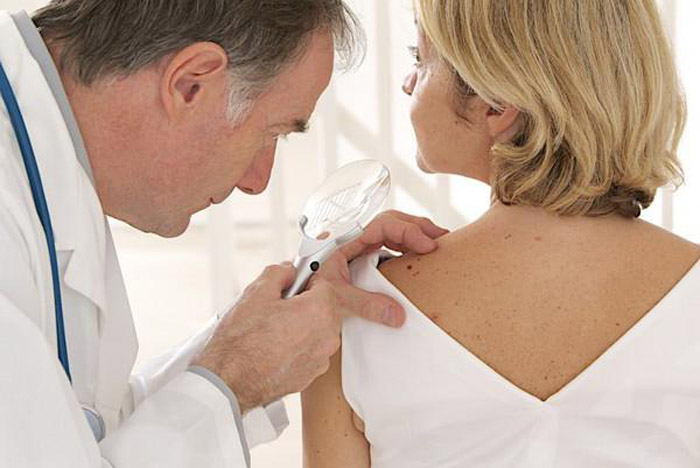
The main sign of the presence of a virus in the body is the appearance of small formations on the body. They only at first glance seem harmless, and can lead to serious health problems.
In 50% of cases, papillomavirus is sexually transmitted, in addition, infection can occur:
- from a sick mother to a child during its passage through the birth canal, the pathogen can also enter the body of a child with breast milk;
- household way – the use of shared towels and other hygiene items;
- self-infection is observed when an existing formation is damaged.
In a latent state, the virus can be considered harmless, but when provoking factors occur, it is activated and manifests itself in the form of skin growths. These factors include:
- exacerbation of chronic diseases;
- diseases of the gastrointestinal tract;
- unhealthy lifestyle – bad habits, malnutrition;
- weakening of the immune system;
- genital infections;
- allergies and autoimmune diseases;
- harmful effects of ultraviolet rays;
- hereditary predisposition;
- prolonged stress;
- elderly age.
Содержание:
When should you go to a specialist?
When growths appear on the skin, a visit to the doctor should not be postponed, even if the formations are small and do not cause any discomfort.
Sign up for a consultation if:
- papillomas on the body;
- warts of various sizes;
- warts – growths on the external genitalia or in the anus.
To begin with, the patient must contact a therapist who will determine the presence of a problem and refer him to a specialist to prescribe adequate treatment.
Why not postpone the visit?
It is necessary to get qualified help, self-removal of skin growths with the help of traditional or traditional medicine is fraught with aggravation of the condition.
Most strains of papillomavirus are not dangerous, they provoke the appearance of benign growths, however, if the formation is injured, certain risks arise:
- Papilloma is a source of viruses. If its integrity is violated, viruses are released into the environment in large quantities. Thus, you can infect people around you, as well as spread the virus through your skin.
- If the papilloma is detached or damaged, there is the possibility of a secondary infection, which can lead to suppuration and even sepsis.
But this is not the worst. The main danger of having papilloma lies in the fact that not all strains of the virus have a low oncogenic status. There are viruses that provoke the appearance of malignant neoplasms, such strains include 31, 33, 35, 39 16, 18, 45, 51, 52, 59, 58, 66 , 68 .

It is impossible to determine the strain on your own, for this you need to undergo special studies. For this reason, if any growths occur on the skin, you must immediately contact a specialist, undergo an examination and begin the correct treatment of the pathology.
Which specialist to go to, who deals with the removal of HPV surgeon or dermatologist?
As mentioned above, you first need to contact a therapist or dermatologist. Further, consultation of narrow specialists may be required, depending on the location of education.
Most often, papillomas appear in places of constant humidity – in the inguinal folds, in the axillary region, on the genitals, and even on the mucous membrane of the growth cavity.
Growth on the neck, on the skin
On the neck, papillomas look like papillary growths that look like cauliflower leaves. The neck is a favorite place for papillomas, and they are injured in this area quite often (friction of a collar, scarf, and so on).
At the initial stage, the growth on the neck may not differ in color from the general skin color, but later it may acquire a pink or brown tint.
Papillomas on the neck are treated by a dermatologist, if he determines that the pathology is caused by an oncogenic strain, he will refer the patient to an oncologist, if necessary, the surgeon will need to remove the neoplasm.
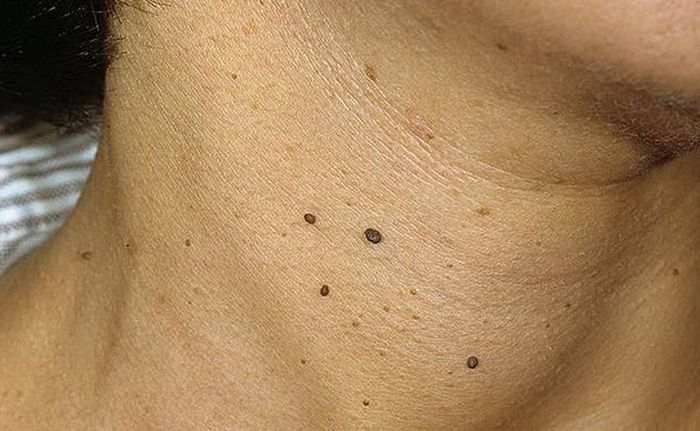
Papilloma on the face
Papillomas on the face can appear in various places. If the neoplasm is located on the eyelid , you need to contact an ophthalmologist, who, after all the necessary tests, will excise the neoplasm. Growths located in close proximity to the organs of vision are removed using a laser, liquid nitrogen or a scalpel.
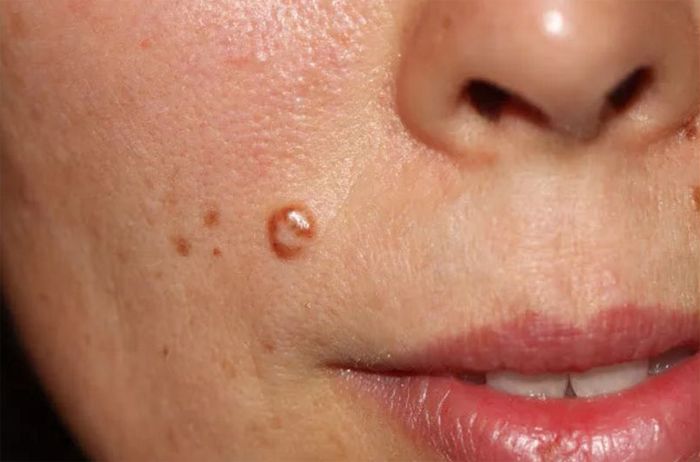
HPV in intimate places on the body in an adult
When the genital papillomavirus of a man is affected, the formations can be located on the penis, around the head and on the scrotum.
In women, papillomas are localized on the large and small labia, on the vaginal mucosa, on the clitoris and on the cervix. In addition, in persons of any gender, papillomas may appear in the anus, urethra and in the inguinal zone.
Papillomas on the genitals can be:
- filiform;
- flat – small bumps that can cause unpleasant itchy sensations.
With genital warts, you should consult a gynecologist or urologist, depending on the gender.
In the oral cavity, papilloma can be recognized by the following signs:
- the size of the neoplasm is approximately 1 cm;
- the surface of the growth is rough;
- papilloma is attached to the mucosa with a thin leg or a wide bottom;
- the color of the neoplasm is light or pinkish;
- the growth does not cause pain when pressed.
In the mouth, on the tongue
If papillomas are detected in the oral cavity, it is necessary to make an appointment with a dentist, who, if necessary, will refer the patient to an oncologist or surgeon.
So, skin diseases are the responsibility of a dermatologist. This specialist should be contacted if there is a papilloma on the face, neck, in the armpit, on the palms, feet, abdomen or back. When papillomas are located in the oral cavity and on the genitals, this doctor does not prescribe treatment, but only conducts a superficial examination.
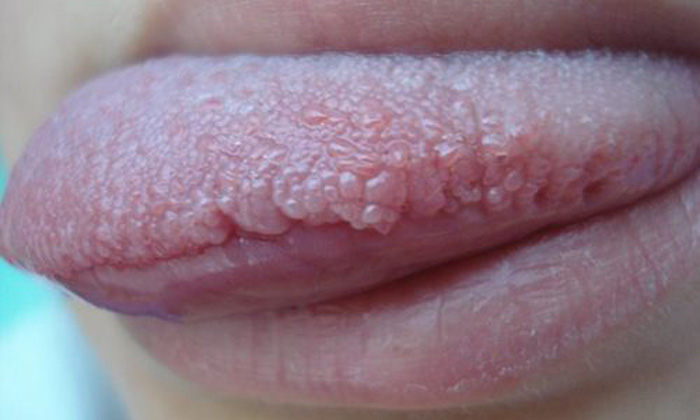
A gynecologist deals with the treatment of genital warts on the intimate organs of women, growths on the genitals of men are treated by a urologist or andrologist.
With papillomas in the anus, it is necessary to contact a proctologist; in addition to a visual examination of the anus, he will conduct a colposcopy to obtain more information about the prevalence of the virus.
If the growths are localized on the inside of the cheeks, on the tongue or under it, you need to go to the dentist, if there are papillomas on the palatine uvula and larynx, you need to consult an otolaryngologist.
An ophthalmologist can prescribe the correct therapy for the location of papillomas on the eyelids. The patient is sent to the surgeon after determining the good quality of the neoplasms, for their removal.
The help of an oncologist is required if a high oncogenicity papillomavirus is found in the patient’s body.
Who treats warts in children?
Papillomas can appear not only in an adult, but also in a child. Most often, the causes lie in the infection of the child with molluscum contagiosum. At risk are children with weak immunity. Children may experience the following types of papilloma :
- vulgar;
- filiform;
- flat;
- plantar;
- papillomatosis of the larynx ;
- warty dysplasia;
- epithelial hyperplasia.
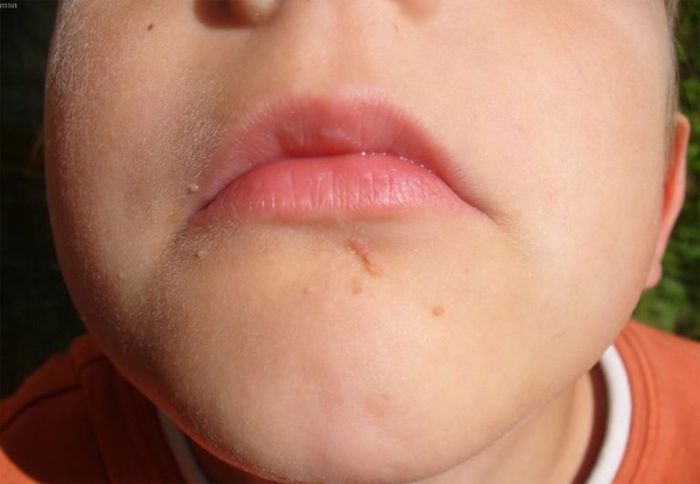
Of course, with any neoplasm on the skin or mucous membrane, it is necessary to show the child to a pediatrician, and if necessary, to a narrow socialist, but the following changes require an immediate visit to the doctor:
- papilloma has become dark red or black;
- education is growing rapidly;
- the growth has acquired an unusual non-rounded shape;
- when you click on education, the child feels pain.
The pediatrician may refer the child to a surgeon or a dermatologist to remove the papilloma from the open area of the skin; to a proctologist or gynecologist if the papilloma is localized in the anus or perineum; with papillomas in the oral cavity, the child is sent to the dentist or otolaryngologist.
How is human papillomavirus diagnosed in men and women?
Diagnostic measures begin in the specialist’s office. He asks in detail about the patient’s condition:
- How long ago did education begin?
- whether its color or shape changes;
- what are the additional symptoms;
- what are the assumptions about the route of infection;
- whether relatives and relatives have papillomas.
After the anamnesis is collected, the doctor visually examines the growths, paying attention to their number, color, structure, size and localization. If the doctor has doubts about the benignness of the neoplasm, he directs the patient for a histological analysis.
To determine the nature of the infection, PCR is prescribed. To determine the strain of the virus and the degree of its oncogenicity, a Digene test is prescribed.
When the papilloma is located on the intimate organs or in the anus, both men and women must undergo a series of additional examinations that will exclude or confirm the presence of neoplasms on the internal organs. Only after a thorough diagnosis, the doctor decides on the need to remove the papilloma and further treatment.
What are the methods of treatment?
Unfortunately, it is impossible to cure the pathology completely, however, with the right approach to therapy, you can stop the activity of the virus and save a person from growths on the skin.
Conservative treatment of the virus consists in the selection of medications that will deactivate the virus and restore the protective functions of the body.
Most often, immunomodulatory injections are learned:
- Cycloferon.
- Interferon alfa.
- Panavir .
- Ingaron.
In addition, tablets are prescribed:
- Isoprinosine.
- Likopid .
- Lavomax.
- Alpizarin.
For the treatment of warts in the intimate area or in the anus, the doctor may prescribe drugs in the form of suppositories.
As for local preparations, therapy can be used:
- Oxolinic ointment.
- Stefalin.
- Salicylic ointment.
- Epigen.
Vitamins are prescribed to strengthen the immune system.
To remove papillomas, the following methods are used:
- scalpel removal;
- electrocoagulation;
- laser therapy;
- freezing with liquid nitrogen;
- radio wave treatment.
Despite the fact that it is impossible to completely get rid of the papillomavirus , it can and should be fought. In order to prevent the reactivation of the virus, it is recommended to follow the rules of personal and intimate hygiene, take vitamin complexes regularly, and streamline your sex life.
The only effective prevention of papillomavirus is vaccination against it, but it is completely useless if the virus has already entered the human body, so it makes sense to do it before the onset of sexual activity.





